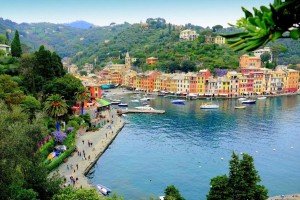Costa Rica's Favorite Meal: The Casado
February 7, 2025
Costa Rica is a fabulous destination for luxury travelers, as well as seniors, couples, and families, not least because of its many excellent dining options.…
Read This Post Liguria is the coastal region occupying the most north-western part of the country, immediately to the east of France. Its capital city is Genoa (Genova in Italian, and birthplace of Christopher Colombus), its famed riviera the place of legends, and its quaint linked towns known as the Cinque Terre one of the most popular destinations in Italy. It is home to gorgeous beaches, cosmopolitan flair, simple homestyle pleasures, and wonderful food, including fresh seafood and the subject of today’s blog: pesto.
Liguria is the coastal region occupying the most north-western part of the country, immediately to the east of France. Its capital city is Genoa (Genova in Italian, and birthplace of Christopher Colombus), its famed riviera the place of legends, and its quaint linked towns known as the Cinque Terre one of the most popular destinations in Italy. It is home to gorgeous beaches, cosmopolitan flair, simple homestyle pleasures, and wonderful food, including fresh seafood and the subject of today’s blog: pesto.
Visit the Cinque Terre on a cooking vacation with TIK.
 Pesto comes from the Genovese form of the Italian word “pestare,” to pound or smash. As its name suggests, the ingredients are traditionally smashed together to form a paste, resulting in a bright green sauce that is used most frequently to dress pasta, but sometimes on vegetables and in soups. The classic Genovese version contains garlic, fresh basil, European pine nuts, Ligurian olive oil, and two types of cheese, usually parmiggiano reggiano or grana padano and pecorino sardo, a sardinian sheeps-milk cheese. Sometimes, as in the recipe that follows, the pine nuts are omitted (much like you will find over the border in Provence, where the similarly made and similarly named pistou is used to dress soups.)
Pesto comes from the Genovese form of the Italian word “pestare,” to pound or smash. As its name suggests, the ingredients are traditionally smashed together to form a paste, resulting in a bright green sauce that is used most frequently to dress pasta, but sometimes on vegetables and in soups. The classic Genovese version contains garlic, fresh basil, European pine nuts, Ligurian olive oil, and two types of cheese, usually parmiggiano reggiano or grana padano and pecorino sardo, a sardinian sheeps-milk cheese. Sometimes, as in the recipe that follows, the pine nuts are omitted (much like you will find over the border in Provence, where the similarly made and similarly named pistou is used to dress soups.)
Try a recipe for pansoti ravioli from Liguria.
 Traditionally, the ingredients are smashed together in a large marble mortar with a wooden pestle. There are of course variations: some common ones are to substitute (or add) almonds or walnuts for the pine nuts, to use pecorino romano instead of pecorino sardo, or to add mint leaves. Some more extreme variations include pesto alla siciliana (Sicilian-style pesto), which is red due to the addition of tomato and almonds, and limiting the basil, or Calabrian pesto, which incorporates bell peppers and black pepper. Of course, outside of Italy there is the habit of calling any similarly-made sauce by the name pesto: hence arugula pesto, spinach pesto, olive pesto, and the like.
Traditionally, the ingredients are smashed together in a large marble mortar with a wooden pestle. There are of course variations: some common ones are to substitute (or add) almonds or walnuts for the pine nuts, to use pecorino romano instead of pecorino sardo, or to add mint leaves. Some more extreme variations include pesto alla siciliana (Sicilian-style pesto), which is red due to the addition of tomato and almonds, and limiting the basil, or Calabrian pesto, which incorporates bell peppers and black pepper. Of course, outside of Italy there is the habit of calling any similarly-made sauce by the name pesto: hence arugula pesto, spinach pesto, olive pesto, and the like.
Browse all our cooking vacations in Italy.
To wrap up our exploration of seaside destinations this week, we could not be more pleased to present Chef Pietro’s recipe for pesto. Chef Pietro, from our Ligurian cooking vacation Seaside Cooking in Splendid Santa Margherita, eschews the pine nuts in favor of a more Provencal type of pesto in which the basil is the real star. Some people say you can only make “real” pesto with young, Genovese-style, small-leaf basil; however, you are more likely to find the larger-leafed Italian variety in the store or at the market, and it works nicely as well!
Learn about the Italian Riviera.
 Pesto Sauce alla Santa Margherita Ligure
Pesto Sauce alla Santa Margherita LigurePrep time: 10 minutes
Cook time: 0 minutes
Ingredients:
Instructions:
1. Smash the ingredients together using a large mortar and pestle.
2. Use to dress pasta, vegetables, or soup. Worried that the amounts are a bit vague? Keep tasting the sauce until you achieve the flavors you prefer: a little more salt, a little less garlic, a little more cheese—you are the judge of what tastes best!
Try these other pasta recipes:
By Peg Kern
Sign up to receive our newsletter, which includes travel tips, recipes, promotions, and information on our best food and wine vacations.
Find more photos, videos, food facts, and travel stories from The International Kitchen on Facebook, Instagram, Pinterest, Twitter, and YouTube.